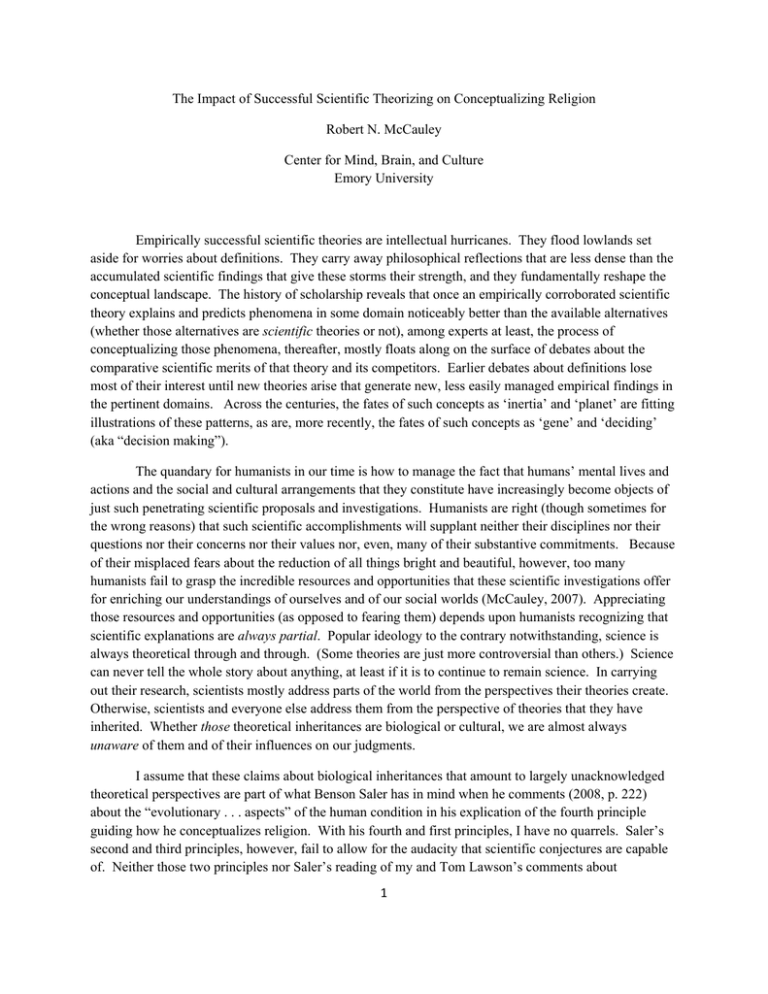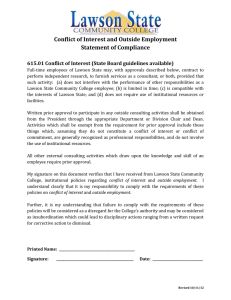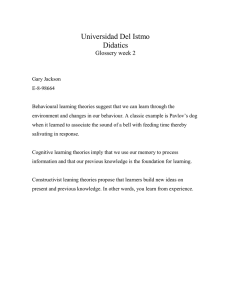The Impact of Successful Scientific Theorizing on
advertisement

The Impact of Successful Scientific Theorizing on Conceptualizing Religion Robert N. McCauley Center for Mind, Brain, and Culture Emory University Empirically successful scientific theories are intellectual hurricanes. They flood lowlands set aside for worries about definitions. They carry away philosophical reflections that are less dense than the accumulated scientific findings that give these storms their strength, and they fundamentally reshape the conceptual landscape. The history of scholarship reveals that once an empirically corroborated scientific theory explains and predicts phenomena in some domain noticeably better than the available alternatives (whether those alternatives are scientific theories or not), among experts at least, the process of conceptualizing those phenomena, thereafter, mostly floats along on the surface of debates about the comparative scientific merits of that theory and its competitors. Earlier debates about definitions lose most of their interest until new theories arise that generate new, less easily managed empirical findings in the pertinent domains. Across the centuries, the fates of such concepts as ‘inertia’ and ‘planet’ are fitting illustrations of these patterns, as are, more recently, the fates of such concepts as ‘gene’ and ‘deciding’ (aka “decision making”). The quandary for humanists in our time is how to manage the fact that humans’ mental lives and actions and the social and cultural arrangements that they constitute have increasingly become objects of just such penetrating scientific proposals and investigations. Humanists are right (though sometimes for the wrong reasons) that such scientific accomplishments will supplant neither their disciplines nor their questions nor their concerns nor their values nor, even, many of their substantive commitments. Because of their misplaced fears about the reduction of all things bright and beautiful, however, too many humanists fail to grasp the incredible resources and opportunities that these scientific investigations offer for enriching our understandings of ourselves and of our social worlds (McCauley, 2007). Appreciating those resources and opportunities (as opposed to fearing them) depends upon humanists recognizing that scientific explanations are always partial. Popular ideology to the contrary notwithstanding, science is always theoretical through and through. (Some theories are just more controversial than others.) Science can never tell the whole story about anything, at least if it is to continue to remain science. In carrying out their research, scientists mostly address parts of the world from the perspectives their theories create. Otherwise, scientists and everyone else address them from the perspective of theories that they have inherited. Whether those theoretical inheritances are biological or cultural, we are almost always unaware of them and of their influences on our judgments. I assume that these claims about biological inheritances that amount to largely unacknowledged theoretical perspectives are part of what Benson Saler has in mind when he comments (2008, p. 222) about the “evolutionary . . . aspects” of the human condition in his explication of the fourth principle guiding how he conceptualizes religion. With his fourth and first principles, I have no quarrels. Saler’s second and third principles, however, fail to allow for the audacity that scientific conjectures are capable of. Neither those two principles nor Saler’s reading of my and Tom Lawson’s comments about 1 conceptualizing religion in our first book, Rethinking Religion (1990), reflect sufficient appreciation of the wallop that victorious scientific theories carry for matters of conceptualization that I have scouted above. The basic problem is that Saler nowhere explicitly grants, though I suspect that he assumes, the fundamental game-changing role that empirically successful scientific theories often play in battles about concepts and definitions. I suspect he assumes it, first, because his first principle cites, approvingly, Karl Popper’s (1962/1992) deflationary comments about the importance of definitions and concerns about the meanings of terms, relative to the importance of the empirical evaluation of scientific theories. Moreover, when Saler (2008, p. 222) announces that his interest is in a “model” of “religion in general,” it is but another way of saying that he seeks a wide-ranging explanatory theory capable of cutting through all of the diversity and complexity that his third principle (properly) stresses. That third principle does not quite go far enough, though. It fails to acknowledge how, in the course of an explanatory theory’s empirical evaluation, its on-going corroboration can entitle it, at least provisionally, to what often initially appear (to more conventional scholars) to be sweeping oversimplifications that cut through that diversity and complexity. Examples from the history of science abound. Newton’s theory explained how everything from a feather’s free fall, to a canon ball’s trajectory, to the motions of the planets conforms to the same principles of motion. In contemporary neuroscience, discoveries about the mechanisms of neuronal interaction and about the role of neurotransmitters, in particular, offer insights about topics as diverse as psychopathologies, psychopharmacology, mood, and working memory. Recent speculations in evolutionary psychology threaten to unearth a hitherto unexpected, underlying conceptual unity among features of human behavior as varied as mate selection, resource distribution, disgust, linguistic facility, discriminative parental solicitude, biological essentialism, morning sickness, face recognition, cheater detection, conditional inference, and the fear of snakes and spiders! Newly triumphant scientific theories often recast how we organize large parts of the world conceptually. In an age of science it is always the on-going empirical corroboration of a wide ranging explanatory theory that proves the preferred ground (at least in the long run) for decisions about how to deploy the key concepts in some domain. For scholars, if not for common folk, empirically successful theories change the rules. Consequently, I fear that the second principle guiding Saler’s conceptualizing of religion (2008, p. 222), which mandates that a definition “ought to satisfy ‘the criterion of intra-cultural intuitivity’ . . .” may underestimate the radical conceptual discontinuities that theoretical advances in science sometimes provoke. Saler’s second principle embraces Spiro’s concern for definitions squaring with pre-reflective intuition. Pre-reflective intuition is usually the point from which explicit theorizing begins. It is not, however, where progressive theorizing ends. That is because sooner or later (usually sooner) the sciences proffer radically counter-intuitive representations that fail to accord with our prereflective intuitions. That is true regardless of whether the pre-reflective intuitions in question arise primarily (a) from humans’ biological inheritances (e.g., the intuition that neither we nor the ground on which we stand are moving, as opposed to both being positioned at the surface of a massive sphere that is spinning at roughly one thousand miles per hour at the equator) or (b) from humans’ inheritances from inexpert culture (e.g., the intuition that someone’s coughing up blood for weeks must be the result of a sorcerer’s nefarious conjuring as opposed to an infection by mycobacterium tuberculosis). Distant 2 illustrations from the history of science can seem quaint, but plenty of readers can recall when earthquakes were understood primarily in terms of a stable but expanding and contracting earth instead of in terms of slippage between massive tectonic plates that can eventually displace entire continents over long periods of time. Even more readers can recall when the culturally entrenched assumptions that informed people’s intuitions concerning such commonplace matters as the etiology and treatment of stomach ulcers were quite different from what they are now. In short, scientific progress in these two areas has transformed how we conceptualize earthquakes and ulcers, respectively. Devotees to claims for a special status for religion or to the famous distinction between the naturwissenschaften and the geisteswissenschaften may find those two examples unconvincing. The danger in each case, however, is that the flipside of such devotion is an abject failure to address what I referred to above as the contemporary “quandary for humanists.” The cognitive, psychological, and brain sciences over the past fifty years have substantially transformed our understandings of our mental lives, of the springs of human action, and of the socio-cultural patterns and processes they engender (Churchland, 1983, Nisbett and Ross, 1980, and Sperber, 1996, respectively). We have come to learn that our conceptions of some of the most basic dimensions of human mental life can be mistaken. Consider the following. Cognitive scientists (e.g., Duchaine, 2000) have, within the last decade, discovered the existence of developmental prosopagnosics. Prosopagnosia is the inability to remember human faces. Clinical neuropsychologists have known about injury-induced prosopagnosia for decades, but no one – not the clinical neuropsychologists nor the developmental prosopagnosics themselves nor their physicians – knew about developmental prosopagnosia. Developmental prosopagnosics appear to be otherwise normal people with normal eyesight, who, under normal viewing conditions and with ample time to examine others’ faces, are, contrary to expectations, incapable of recognizing those faces even after comparatively short delays. They can recognize all of the other sorts of things that people would commonly recognize in such circumstances such as clothing, voices, stature, etc. These people see and remember what other people remember, except for human faces. One sort of thing that they see, viz., human faces, does not seem to register. With prosopagnosia, what appear to be, otherwise, normal human minds can, in effect, be incapable of remembering only one specific type of information about stimuli that that they have no trouble seeing. They have not suffered any injuries. They are not amnesic. This is one of dozens of discoveries in the cognitive sciences over the past few decades that suggest that our commonsense conceptions of what it is like for a human to perceive, think, and remember may be unduly narrow. The cognitive science of religion was born less than twenty years ago. Cognitive scientists of religion have only begun to explore how such findings and additional findings of their own (e.g., Cohen, 2007) may reconfigure our views about religious experience, religious emotion, religious cognition, and religion overall. The conceptions that undergird humans’ intuitions about socio-cultural forms are similarly suspect. The cognitive sciences are also transforming our conceptualizations of humans’ social and cultural arrangements. Robin Dunbar (1993; 1996) has famously argued that human minds seem peculiarly ill-equipped to think about the behaviors of large groups of people. He maintains that human brains are built to monitor the complex social relations of groups that are no larger than one hundred eighty people or so. Even in matters as serious as international relations, humans are content for political leaders, diplomats, and journalists to compensate for their lack of analytical insight into large groups by 3 relying on personifying them. So, instead of demanding careful, fine-grained studies of group dynamics and of features and trends among populations, we usually settle for intuitive pronouncements about how the French remember the history of German invasions of their country or about what China thinks about continuing to finance American government debt. Even a moment’s reflection on the myriad views (and their implications for individuals’ actions) of tens of millions of people in the first case and of more than a billion in the second should give us some pause about this intuitively appealing, but analytically problematic, technique for handling such matters. Pronouncements about what Muslims in India think about the 2008 terrorist attacks on Mumbai or how American Evangelicals will react to an economic recovery plan by a new Obama administration are no less problematic. Experimental research on cognition across cultures (e.g., Henrich et al., 2004) suggests striking variability on some fronts, much of which inevitably fails to accord with our everyday intuitions about human sociality and human groups. As the list of counter-examples to familiar presumptions about the character of religion, with which Pascal Boyer opens his book, Religion Explained (2004), indicates, further research in the social and cognitive sciences may substantially reorient how we conceptualize all things religious. The reservations I have lodged about Saler’s second and third principles concern what are usually small differences in practice. They are, however, small differences that can, occasionally, make big differences with respect to how we conceptualize phenomena in some domain, as the various illustrations from the history of science that I have offered above attempt to show. It is not just Saler’s formulations of his second and third principles that suggest that he has overlooked these possibilities, though. The more telling evidence is his reading of my and Lawson’s views about these matters in Rethinking Religion. In that book Lawson and I advance a cognitively grounded theory about various features of (what will, from a pre-reflective standpoint, prove to be but a subset of what both the public and previous scholars take to be) religious rituals. Saler overlooks our sensitivity to and focus upon the influence of scientific theorizing (about anything) for the conceptualization (of anything), even in passages he quotes! He attributes to us a strong, explicitly “essentialist” (2008, p. 221) conceptualization of religion on the basis of texts that do not commit us to any such thing. Both in passages that Saler quotes and in many other passages that he does not quote, we consistently emphasize that our claims about religion and religious ritual are advanced “for the purposes of theorizing,” that the principles that we proffer are “theoretical,” that our project “explores and extends . . . theoretical commitments that must underlie definitions of religion in terms of culturally postulated superhuman agents,” that “the theory we advance offers clear, theoretically inspired criteria” for how to manage non-prototypical cases, and, most importantly, that “this theoretical proposal . . . makes numerous assumptions about religion . . .” and thus that “its success should substantially constrain subsequent theorizing about religious systems” (Lawson and McCauley, 1990, pp. 5, 5-8, 6, 7 and 8, respectively, with some emphasis added). It follows that our claims about features that we take to be either “universal” or “unique” (Lawson and McCauley, 1990, pp. 6 and 7) with regard to our theoretically inspired and theoretically restricted, technical notion of religious rituals are not equivalent to claims that those are either necessary or essential features of religion or even of religious rituals as they are commonly construed pre-theoretically. That is precisely why, as Saler correctly notes, that we persist in using the explicit language of prototypicality (nothing “sub-textual” there!), rather than the language of definition, throughout the remainder of the book, when our discussion touches upon matters of conceptualization. 4 Finally, as we sketched in Rethinking Religion and as we have underscored in many subsequent writings (see, for example, McCauley and Lawson, 1996, 1998, 2002 and McCauley, 2003 and 2004), once explicit scientific theorizing and empirical evaluation of those theories are underway, considerations of definition and conceptualization should not wag the dog of inquiry in empirical science. In just the Popperian spirit that Saler extols, Lawson and I have always taken matters of definition and conceptualization to be both secondary to and shaped by the assessment of the empirical merits of vying scientific theories, including theories about religion or religious matters. References Boyer, P. (2001). Religion Explained: The Evolutionary Origins of Religious Thought. New York: Basic Books. Churchland, P.S. (1983). "Consciousness: The Transmutation of a Concept," Pacific Philosophical Quarterly 64, 80-93. Cohen, E. (2007). The Mind Possessed: The Cognition of Spirit Possession in an Afro-Brazilian Religious Tradition. Oxford: Oxford University Press. Duchaine, B. (2000). “Developmental Prosopagnosia with Normal Configural Processing,” NeuroReport 11(1), 79-83. Dunbar, R. (1993). “Coevolution of Neocortical Size, Group Size and Language in Humans,” Behavioral and Brain Sciences 16, 681-694. Dunbar, R. (1996). Grooming, Gossip, and the Evolution of Language. Cambridge: Harvard University Press. Henrich, J., Boyd, R., Bowles, S., Gintis, H., Fehr, E. and Camerer, C. (eds.) (2004). Foundations of Human Sociality: Ethnography and Experiments in 15 Small-scale Societies. New York: Oxford University Press. Lawson, E. T. and McCauley, R. N. (1990). Rethinking Religion: Connecting Cognition and Culture. Cambridge: Cambridge University Press. McCauley, R. N. (2007). “Reduction: Models of Cross-Scientific Relations and Their Implications for the Psychology-Neuroscience Interface,” Handbook of the Philosophy of Science: Philosophy of Psychology and Cognitive Science. P. Thagard (ed.). Amsterdam: Elsevier, pp. 105-158. McCauley, R. N. (2003). “Is Religion a Rube Goldberg Device? Or Oh, What a Difference a Theory Makes!” Religion as a Human Capacity: A Festschrift in Honor of E. Thomas Lawson. B. Wilson and T. Light (eds.) Leiden: Brill, pp. 45-64. 5 McCauley, R. N. (2004). “Philosophical Naturalism and the Cognitive Approach to Ritual,” Thinking through Ritual. K. Schilbrack (ed.). London: Routledge, pp. 148-171. McCauley, R. N. and Lawson, E. T. (1996). "Who Owns 'Culture'?" Method and Theory in the Study of Religion 8, 171-190. McCauley, R. N. and Lawson, E. T. (1998). "Interactionism and the Non-Obviousness of Scientific Theories," Method and Theory in the Study of Religion 10, 61-77. McCauley, R. N. and Lawson, E. T. (2002). Bringing Ritual to Mind: Psychological Foundations of Cultural Forms. Cambridge: Cambridge University Press. Nisbett, R. and Ross, L. (1980). Human Inference: Strategies and Shortcomings of Social Judgment. Englewood Cliffs, New Jersey: Prentice-Hall. Popper, K. (1962/1992). Conjectures and Refutations. New York: Routledge. Saler, B. (2008). “Conceptualizing Religion: Some Recent Reflections,” Religion 38, 219-225. Sperber, D. (1996). Explaining Culture: A Naturalistic Approach. Oxford: Blackwell Publishers. 6





